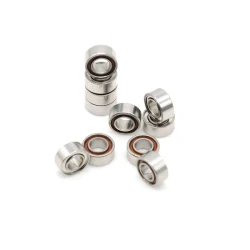Types of Bearing
2023-11-29
Bearings are mechanical components that enable rotational or linear movement while reducing friction and supporting loads. There are various types of bearings, each designed for specific applications. Here are some common types of bearings:
1. Ball Bearings:
- Deep Groove Ball Bearings: Suitable for radial and axial loads, commonly used in applications like electric motors and gearboxes.
- Angular Contact Ball Bearings: Designed to handle both radial and axial loads, especially in applications with combined loads and high-speed rotations.
2. Roller Bearings:
- Cylindrical Roller Bearings: Provide high radial load capacity and are suitable for applications with high speeds.
- Tapered Roller Bearings: Can support both radial and axial loads, commonly used in car hubs and gearboxes.
- Spherical Roller Bearings: Accommodate misalignment and axial loads in addition to radial loads, suitable for heavy-duty applications.
3. Needle Roller Bearings:
- Have a high length-to-diameter ratio and are suitable for applications with limited radial space.
4. Thrust Bearings:
- Ball Thrust Bearings: Designed to handle thrust loads in one direction.
- Roller Thrust Bearings: Can handle larger thrust loads than ball thrust bearings.
5. Plain Bearings:
- Bushings or Sleeve Bearings: Simple and cost-effective, often used in low-speed and high-load applications.
- Spherical Plain Bearings: Allow for angular misalignment and are suitable for oscillating movements.
6. Mounted Bearings:
- Bearings that come pre-assembled in housings for specific applications, such as pillow block bearings and flange bearings.
7. Linear Bearings:
- Linear Ball Bearings: Used in linear motion systems to provide smooth and precise motion.
- Linear Roller Bearings: Similar to linear ball bearings but use rollers for higher load capacity.
8. Air Bearings:
- Use a thin film of pressurized air to support loads, providing ultra-low friction and high precision.
9. Magnetic Bearings:
- Use magnetic fields to levitate and support loads, eliminating the need for physical contact.
10. Flexure Bearings:
- Use flexible elements instead of rolling elements, often employed in precision instruments.
The choice of bearing type depends on factors such as the type of load, speed, precision requirements, environmental conditions, and space constraints in a particular application. Each type of bearing has its advantages and limitations, and selecting the right one is crucial for optimal performance and longevity.



